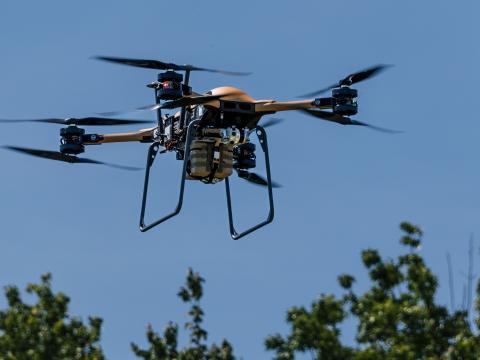Marines Take a Chomp Out of Multiple Radars
 |
| The Ground/Air Task-Oriented Radar (G/ATOR) combines five U.S. Marine Corps legacy radars into one, offering enhanced capabilities and reduced operation and maintenance costs to the Corps. The system has a planar antenna and employs active electronically scanned array radar technology. |
The U.S. Marine Corps is combining five radars into one and planning to attach the result to the back of a tactical vehicle to haul it around. By using state-of-the-art, active electronically scanned array radar technology, Marines will have a highly mobile, multipurpose tool that will help commanders track threats in the air and on the ground. The device will address multiple asymmetric threats targeted at troops and offer them the capabilities they need to be effective in battle in the 21st century.
The Marine Corps is scheduled to begin combating enemies with the Ground/Air Task-Oriented Radar (G/ATOR) within the next decade, starting with an increment one rollout in 2012. The device’s most important role is air surveillance; the system will offer enhanced capabilities to detect, track and provide target-quality data to engage hostile aircraft, cruise missiles, unmanned aerial vehicles (UAVs), rockets, mortars and artillery. It also includes air traffic control functions. All the air radar modes can operate simultaneously, providing Marine Air Ground Task Force (MAGTF) commanders with all the information they need through one device.
The various functions of the G/ATOR meld and combine through the Marines’ air and ground command and control (C2) nodes. The radar will detect its targets and send all the associated information to the C2 systems, whether they are ground or air. The data from G/ATOR will be amalgamated with individual systems. The information can be integrated at a higher level with other services or passed directly to the joint battlefield. John McGough, program manager for G/ATOR, explains that the radar will have an air mode and a ground mode. The air mode includes four aviation systems, and the ground mode is one ground radar.
G/ATOR can operate in those multiple air modes simultaneously and track more targets coming in because it employs active electronically scanned array (AESA) radar technology. Using the AESA on G/ATOR, commanders can run all the radar functions connecting into the Marine Corps’ air C2 node at once. This is especially important for air surveillance because in the foreseeable future, UAVs will become more prolific and deliver more weapons. UAVs have become easily procurable and have comparatively low prices, making them convenient platforms for weapons transport and launch.
AESA radars are composed of many small transmit/receive modules, and they employ very short scanning rates. G/ATOR’s AESA architecture enables multimission performance as well as the ability to adapt automatically to changing conditions on the battlefield. The system also incorporates a scalable open-system architecture and multinetwork connectivity. The latter feature enables it to connect to partner C2 systems. Another innovative feature of G/ATOR is that it is air-cooled instead of water-cooled.
G/ATOR is the Marines’ materiel response to a joint interest requirement for a multirole radar system, which the Joint Requirements Oversight Council approved in July 2004. It will replace technologies that are archaic and reduce the logistics requirements necessary for separate systems. “The fielded radar systems are working, but they are obsolete,” McGough explains. The program falls under the control of Program Executive Office Land Systems (PEO LS) within the Marine Corps Systems Command at Marine Corps Base Quantico, Virginia.
The technology will be released in four increments, beginning with an air surveillance radar that will offer three-dimensional coverage of areas invisible to the AN/TPS-59(V)3 radar because of line-of-sight limitations. This first increment will replace the AN/TPS-63, AN/MPQ-62 and AN/UPS-3 radars. McGough calls increment one a “gap filler” because it provides coverage where other radar cannot because of the Earth’s curvature, offering beyond-line-of-sight radar coverage. He also says the first increment is the keystone and foundation for the rest of the program because it includes all the basic hardware of the system. Increment two, for example, is planned to be only a software upgrade to increment one.
The second increment of G/ATOR will add an indirect-fires locating capability. In addition to determining the origin of mortar, artillery and rocket attacks, it can provide target location information to friendly counterfire weapons. It also will aid in damage assessment by offering “did hit” data to friendly weapons systems. Increment two replaces the AN/TPQ-46 radar.
Increment three upgrades increment one’s air mission capabilities and will encompass improvements generally called engineering change proposals, McGough says. The enhancements include advanced combat identification circuitry and software, integration with the Navy/Marine Corps Cooperative Engagement Capability and Composite Tracking Network, and advanced electronic countermeasures. Marines can choose not to deploy increment three changes when they engage in battle.
Increment four replaces the AN/TPS-73 radar and the airport surveillance radar portion of the AN/TPN-31A Air Traffic Navigation Integration and Coordination System Radar. With the implementation of the fourth portion of the project, the Marine Corps over time will be able to retire all of its legacy radar systems, operating only the G/ATOR and the AN/TPS-59(V)3.
G/ATOR will operate in the S band—between 2 gigahertz and 4 gigahertz—of the spectrum, encompassing parts of both the ultrahigh frequency and super high frequency. Northrop Grumman Electronic Systems, Baltimore, G/ATOR’s prime contractor, selected the S band in the company’s proposal for the work; the Marine Corps did not specify an operating frequency in its request for proposals. After reviewing the various choices, the Marines determined that the S-band option offered the best balance of air surveillance and tracking capabilities. The lower frequencies of the spectrum are better for searching large areas of airspace, and the higher frequencies provide more accuracy.
 |
| Using G/ATOR, Marine Corps commanders will be able to anticipate and counter many threats more effectively, promoting success on the battlefield. Here, two light-armored reconnaissance vehicle crews assigned to the 24th Marine Expeditionary Unit take a break during an exercise in the U.S. Central Command’s area of responsibility. |
The antenna will remain on the trailer during operations. Marines can set up the G/ATOR with all the equipment towed by the two vehicles, then break it down and move it to the next location before setting it back up. With its relatively light weight, the G/ATOR also could be carried under certain aircraft, such as a helicopter or an Osprey, after being unloaded from the trailers.
By combining multiple radar systems, the Marine Corps saves time, effort and funding on logistics. According to PEO LS, 65 percent of a systems’ total life-cycle cost is logistics sustainability. This convergence of multiple devices into a common tool also eliminates much of the parts and supplies needs currently experienced by the Corps for radar systems. McGough says the military branch also is examining whether to combine the schoolhouses that train operators for the disparate systems into a single program to train everyone on the operation of the G/ATOR. Costs for training will be reduced because all personnel will receive instruction on the same system.
The Marines plan to acquire a total of 81 G/ATOR systems sometime before 2020, depending on funding and other decisions. The acquisition strategy is to have full operational capability by 2017. Preliminary design review was completed earlier in 2008. The critical design review, as well as Milestone B decisions for increments two and three, is scheduled to be made sometime this month. Increment four Milestone B approval is planned for 2012.
Though PEO LS wants to hold to the 2012 date for the increment one rollout, if officials believe they can enhance the system by waiting, they will. The program focuses on the technology edge and technology breakthroughs. It places primary importance on providing the best and the most capability to the warfighter. It is designed to insert technology improvements as necessary. Marine Corps officials work closely with Northrop Grumman Electronic Systems to ensure the tool will meet all of the military branch’s requirements. McGough’s team is closely integrated with its private-industry partners.
Offering MAGTF commanders one integrated asset that they can reallocate as necessary is the major advantage of the new system, McGough says. Leaders can place it where they need it most and move it as the mission requires, fulfilling the needs of an expeditionary fighting force. G/ATOR is a combat enabler because one of its inherent qualities is the ability to predict and inform forces what threats are in the field before troops are confronted with the danger. The radar system will detect for whatever mode commanders need at a given moment and allow Marines to distribute the information as necessary.
The Marine Corps already has had situations where the capabilities the G/ATOR will offer would have come in handy. When Hezbollah launched an attack in
Web Resources
Ground/Air Task-Oriented Radar: https://www.marcorsyscom.usmc.mil/peolandsystems/GATOR.aspx
Northrop Grumman Electronic Systems: www.es.northropgrumman.com



Comments